8.04.2020
Find out when and where to see Comet ATLAS (C/2019 Y4) — and stay tuned to see how bright (or not) this comet gets.
UPDATE APRIL 7, 2020 — POSSIBLE BREAKUP

Quanzhi Ye and Qicheng Zhang
No, no, no. Say it ain't so. In a recent Astronomical Telegram, astronomers Quanzhi Ye (University of Maryland) and Qicheng Zhang (Caltech) report that photographs taken on April 2nd and April 5th of the comet revealed a marked change in the appearance of its core or pseudo-nucleus from starlike and compact to elongated and fuzzy. A second team of astronomers led by I. A. Steele (Liverpool John Moores University) confirmed the discovery. This change in appearance is "consistent with a sudden decline or cessation of dust production, as would be expected from a major disruption of the nucleus," wrote Zhang and Ye.

José Chambó Bris (left) and Gianluca Masi
An elongated nucleus is often a bad sign and could mean the comet's headed for disintegration much like what happened to Comet Elenin (C/2010 X1) prior to its September 2011 perihelion passage when its core crumbled and the object rapidly dissipated. Addition evidence of ATLAS's breakup comes from an unexpected shift in the direction of its orbital motion caused by "non-gravitational" forces. Fragmentation exposes fresh ice to sunlight which quickly vaporizes. The expanding gases act like a natural rocket engine and gently push the comet from its appointed path.
No cause has been assigned to the fragmentation but recent studies indicate that accelerating spin may play a significant role in nuclear breakups. Jets of gas blasting away from the comet can spin it up, stressing the icy body until it develops cracks that lead to a breakup.
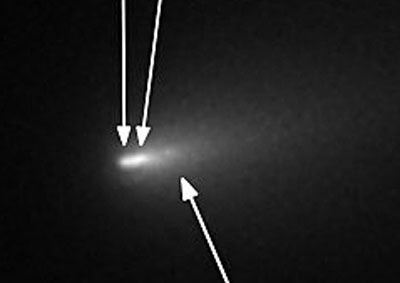
Nick Haigh
In late March Comet ATLAS began to plateau in brightness; now it appears to be slowly fading. The latest estimates place the comet around magnitude 8.5–9. I strongly encourage you to observe it at every opportunity and share your observations in the comments area. Observers with larger instruments working at high magnification may be able to discern larger nuclear fragments. I spotted the comet with my 15-inch scope in bright moonlight on April 8.14 UT and observed that the brightness and density of the nuclear region had declined from an observation made 10 days ago.
While it's possible ATLAS has lost only a single small fragment and will soldier on to perihelion and naked-eye visibility, the optics aren't looking good at the moment. Full Moon occurs on April 7th but a dark-sky window returns as soon as the 9th. Seize the night to enjoy Comet ATLAS at every opportunity before it (possibly) is no more.
The original article, published March 27th, appears below:
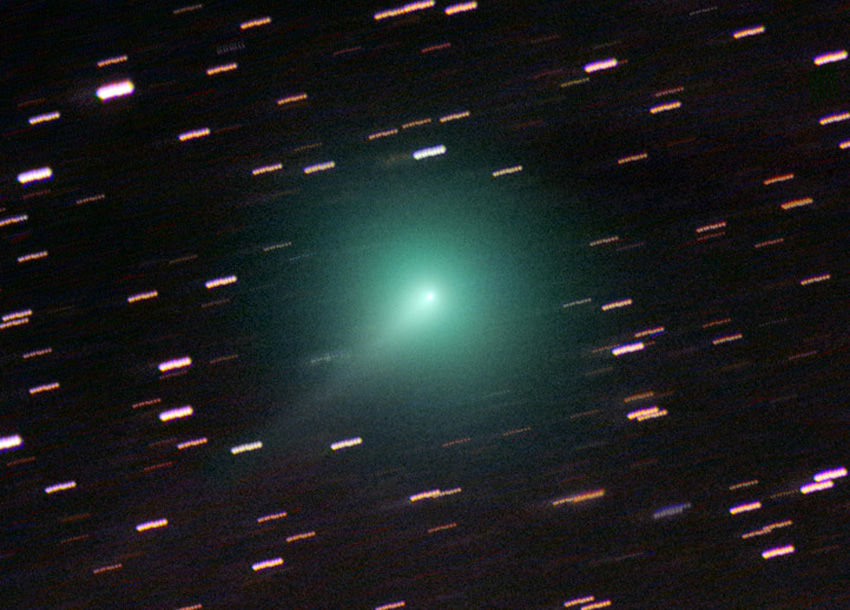
Chris Schur
Not since Comet 46P/Wirtanen passed near the Pleiades star cluster in December 2018 has a naked-eye comet graced the night sky. That may soon change. On December 28, 2019, astronomers with the automated Asteroid Terrestrial-impact Last Alert System (ATLAS) survey discovered a 20th-magnitude comet in Ursa Major that was subsequently named Comet ATLAS (C/2019 Y4).
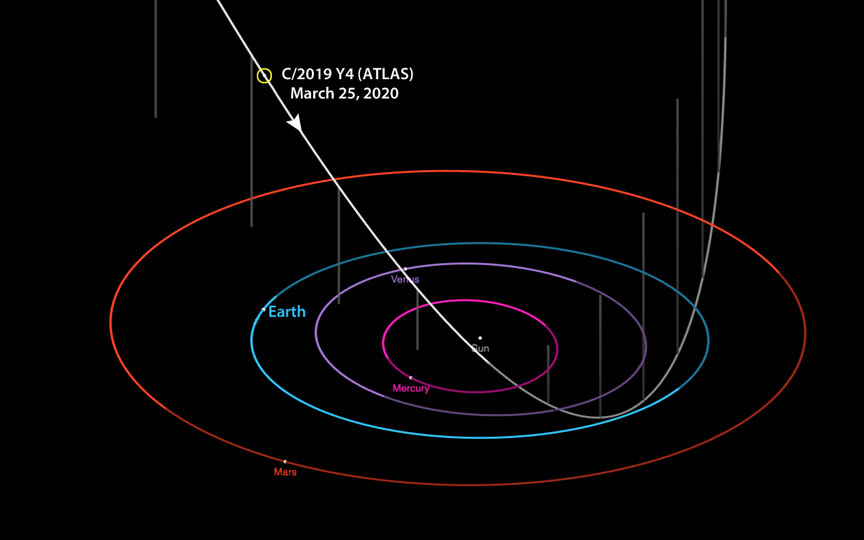
NASA / JPL Horizons
Once a reasonable orbit was determined, Comet ATLAS proved a close match to the Great Comet of 1844 (C/1844 Y1). Both have periods around 4,000 years, approach within 0.25 astronomical unit (a.u.), or 37.4 million kilometers, of the Sun at perihelion, and are inclined 45° to the ecliptic. These and other orbital similarities were strong enough to conclude that both objects were fragments of a single, much larger comet that broke apart about 5,000 years ago. For all we know there may be additional fragments en route for future appearances.
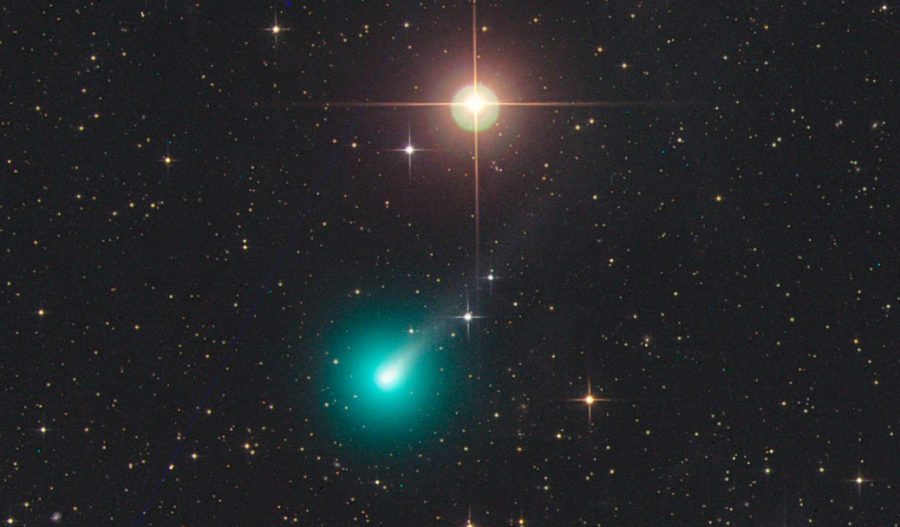
Gerald Rhemann
Because the Great Comet reached 2nd magnitude and grew a 10° tail in January 1845 many of us wondered if its sibling might be capable of doing the same. The answer is a qualified "yes." But one thing is certain — the comet is brightening exponentially.
A BRIGHTENING COMET
Back on February 16th, Comet Atlas was a 14th-magnitude wisp 30″ across and barely brighter than the sky background through my 15-inch telescope. Three weeks later on March 6th the coma had grown to about 5′ and become more compact with a magnitude of 11. By mid-March I snared it with a pair of 10×50 binoculars at magnitude 9 from a dark-sky site. Other observers have reported a similar rapid uptick.
Khalid Baheyeldin
HOW BRIGHT WILL COMET ATLAS BE?
While a hundredfold increase in brightness in a month makes a comet lover's heart palpitate, it could also mean that the comet's volatile ices are rapidly vaporizing as it nears the Sun. Once those materials are depleted some astronomers expect Comet ATLAS's brightness curve to flatten out, a common occurrence in comets that have rarely or never come close to the Sun before. Long-period comets that approach within 1 a.u. of our star have been known to split apart, disintegrate, and disappear. Comet ISON (C/2012 S1) offers a classic example. Shortly before its November 2013 perihelion, the comet crumbled into a cloud of dust and ice, dashing hopes for the spectacle so many of us had anticipated.
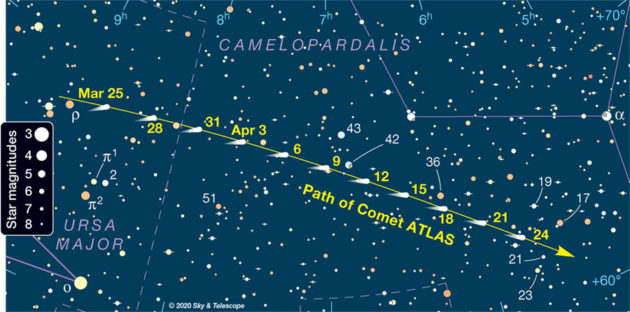
Sky & Telescope
According to NASA’s JPL Horizons the comet could reach magnitude –5, exceeding Venus in brightness at perihelion on May 31st. Because it will lie 13° southwest of the Sun at that time, it might be possible to see the object in broad daylight with a properly shielded telescope.
That prediction may be overly optimistic however. In a March 19th notice from the Central Bureau for Astronomical Telegrams (CBAT), Director Daniel Green applied a formula based on the behavior of previous long-period, Sun-hugging comets and derived a more conservative peak magnitude of –0.3.
It's good news either way. In both predictions Comet ATLAS will reach naked-eye brightness in mid-May before it's lost in the solar glare. The JPL Horizons formula predicts a peak magnitude between 1 and 2, while Green anticipates that number to be between 2 and 3. During the first half of May the comet will appear low in the evening sky at dusk and early nightfall as it tracks through Perseus. Binoculars should reveal a bright, strongly condensed coma followed by dust and gas tails pointing away from the Sun. With a little luck we might even see the tail without optical aid.
After rounding the Sun, Comet ATLAS returns to view around June 15th at dawn in Orion for Southern Hemisphere skywatchers. Initially glowing at magnitude 3 or 4, the comet will fade quickly — assuming it survives a sizzling perihelic encounter!
HOW TO SEE COMET ATLAS
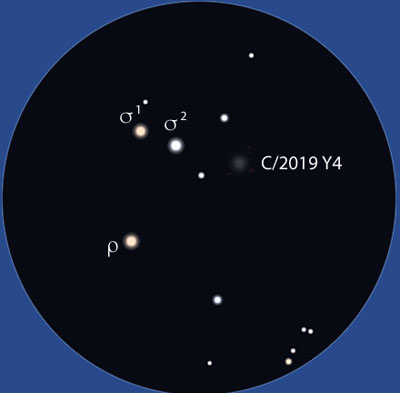
Bob King
For now, observers in the Northern Hemisphere can follow the comet from Ursa Major through Camelopardalis with a 6-inch or larger telescope. While visible in binoculars the comet is still quite diffuse and takes some effort to see. That should change soon.
In a telescope, Comet ATLAS shows a large, diffuse coma with a small, more compact knot at the center dotted with a faint, starlike nucleus. If you have a Swan band filter, which enhances carbon emissions from gas-rich comets, you'll find that Comet ATLAS responds well. I noted a distinct increase in the comet's contrast and visibility through the filter this month.
And what would comet-watching be without a picturesque "deep-sky drive-by" or two? Watch for Comet ATLAS to buzz within a degree of the galaxy NGC 2366 on April 3rd and pass directly in front of the pretty open cluster NGC 1545 in Perseus on May 14th.

Tom Ruen
The comet remains a circumpolar object for much of the U.S. and Europe until about two weeks before perihelion, when best viewing will be during the early evening hours. If the comet is especially dusty, we'll likely see a more spectacular tail instead of a bright, spiked fuzz ball. Be hopeful, but as always when it comes to these fragile objects, temper your expectations.
As Comet ATLAS approaches perihelion, I'll update with new maps and information. I'd love to hear what you're seeing and encourage you to share your observations and thoughts in the comments section. We all need some good news right now given the havoc wrought by the coronavirus. Comets have traditionally been viewed as bearers of malevolence throughout much of human history. In a twist of irony this latest emissary from the remote depths of the solar system may offer a needed dose of wonder.
Quelle: Sky&Telescope
